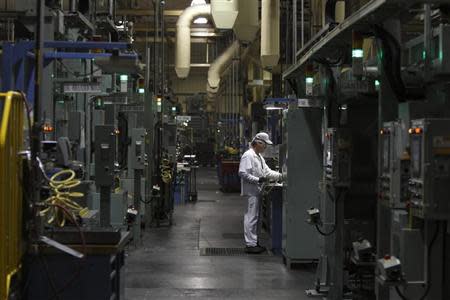U.S. factories flex muscle after severe winter chill
By Lucia Mutikani WASHINGTON (Reuters) - U.S. manufacturing output recorded its largest increase in six months in February and factory activity in New York state expanded early this month, the latest signs the economy was gaining momentum after being dampened by severe weather. Monday's fairly upbeat factory data should encourage the Federal Reserve to further scale back its monetary stimulus this week, even though a separate report suggested the housing sector would take a while to pull out of its recent soft patch. "The economy's engines are starting back up after a cold January. It makes us more confident the economy will continue to move forward as the year progresses," said Chris Rupkey, chief financial economist at Bank of Tokyo-Mitsubishi UFJ in New York. Factory production increased 0.8 percent in February, its largest advance since last August, after a 0.9 percent January drop, the Federal Reserve said. Economists had expected a gain of 0.2 percent. In a separate report, the New York Fed said its "Empire State" business conditions index, which measures factory activity in the state, rose to 5.61 in March from 4.48 in February. New orders, shipments and inventories all increased. The manufacturing data added to evidence from retail sales to employment that has suggested the economy was regaining strength after a an abrupt slowdown at the end of 2013 and early this year, as an unusually cold winter took its toll. Still, growth in the first quarter is expected to be quite a bit weaker than it was in the final three months of last year as businesses work through a pile of unsold goods. Last month, the government estimated the economy expanded at a 2.4 percent annual rate in the fourth quarter, but that figure is expected to be revised to about 3 percent next week. But with job growth accelerating and manufacturing output rebounding, economists expect the Fed to announce another $10 billion reduction to its monthly bond purchases when policymakers conclude a two-day meeting on Wednesday. "The gains should be enough to reassure policymakers at the Fed that the economy continues to make forward progress," said John Ryding, chief economist at RDQ Economics in New York. HOUSING SEEN LAGGING Stocks on Wall Street rallied on the data and easing concerns over the situation in Crimea. The U.S. dollar fell marginally against a basket of currencies and prices for U.S. Treasury debt slipped. A third report showed sentiment among homebuilders edged up in March. Builders were, however, pessimistic about sales over the next six months. They also worried about shortages of lots and skilled labor, and rising prices for materials. "This corroborates reports of a decline in orders from some of the big homebuilders recently, although land shortages may be playing a part," said Jennifer Lee, a senior economist at BMO Capital Markets in Toronto. "This suggests some caution on the new home sales and housing starts front." Housing activity has slowed considerably since last summer, when mortgage rates spiked. Though borrowing costs have eased a bit, high home prices because of tight inventories are making houses less affordable, especially for first-time buyers. Motor vehicle output rebounded 4.8 percent last month after tumbling 5.2 percent in January, the Fed said in its report. There were also notable gains in the production of machinery and fabricated metal products. Mining output rose 0.3 percent last month, but utilities production fell 0.2 percent. The rise in manufacturing and mining output helped to lift overall industrial production 0.6 percent in February. It had slumped 0.2 percent in January. The amount of industrial capacity in use increased to 78.8 percent in February from 78.5 percent. Still, it remained 1.3 percentage points below its long-run average. Officials at the Fed tend to look at capacity use as a signal of how much "slack" remains in the economy, and how much room there is for growth to run before it becomes inflationary. (Reporting by Lucia Mutikani; Additional reporting by Rodrigo Campos in New York; Editing by Paul Simao)



